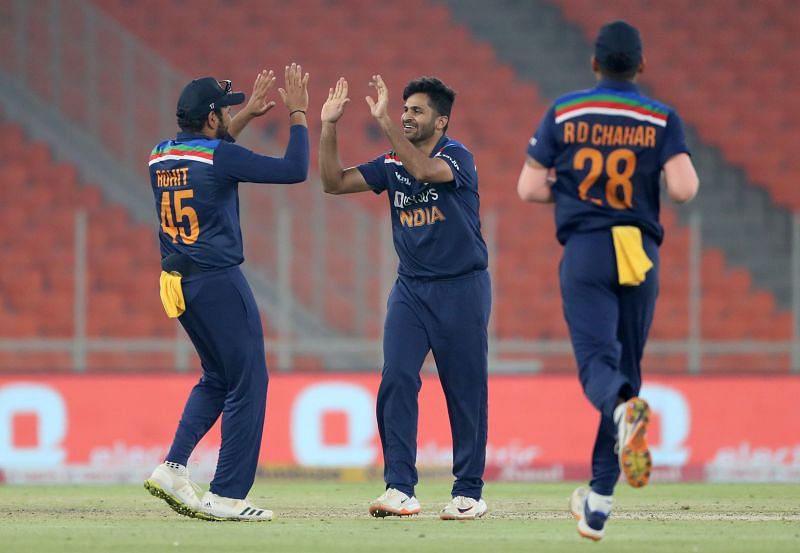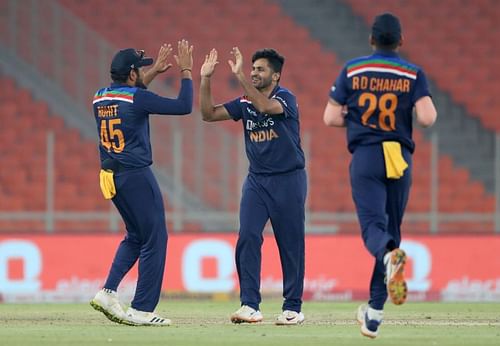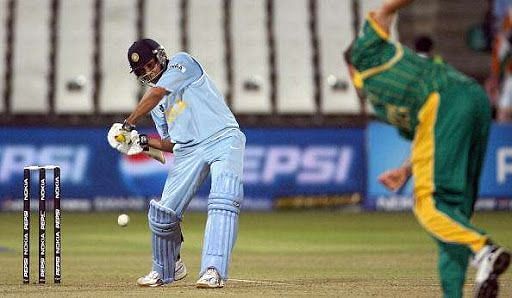
Rohit Sharma, Shardul Thakur, and the man who gifted Indian cricket these two gems

Bhuvneshwar Kumar's frugal spell after Rohit Sharma and Virat Kohli's boisterous partnership helped India win the fifth T20I against England in Ahmedabad on Saturday (March 20). They also notched up their sixth consecutive series victory in the shortest format, the turning point of which came in the previous match on Thursday (March 18).
With a red-hot Ben Stokes and captain Eoin Morgan out in the middle, and England needing 46 runs off 24 balls, Shardul Thakur ran in to bowl the 17th over. And the match turned on its head almost immediately.
The Mumbai pacer snapped up both batsmen off consecutive deliveries to knock the wind out of England's sails. The visitors eventually fell short by 8 runs.
Earlier, Shardul Thakur had played a vital role with the bat as well. He smashed 10 off 4 balls, comprising two boundaries off Jofra Archer in the final over. In essence, the cameo proved to be the difference between the two sides. No wonder Shardul Thakur was the Dream11 Gamechanger of the Match for landing those twin blows with both the bat and ball.
Interestingly, he almost replicated his bowling efforts in the final match by removing Jonny Bairstow and a well-set Dawid Malan in a span of four deliveries. And England never recovered from the jolt as they collapsed from 140 for 2 to 174 for 8, and eventually lost by 36 runs.
For people still doubting Shardul Thakur’s place in the national team, his performance in the fourth T20I was a befitting reply to them all. Notably, it came exactly two months after his Gabba heroics in which he scored 69 runs (67 & 2) and scalped 7 wickets (3/94 & 4/61).
However, none of this baffles Dinesh Lad, Shardul Thakur's childhood coach, who has been seeing such rounded efforts from him for 15 years now.
In an exclusive interview with Sportskeeda, Lad – who is the father of Mumbai cricketer Siddhesh Lad – narrated the incident of how a similar performance from a 14-year-old Shardul had convinced the former that the kid was a special talent.
“When I first saw him, he had come to play against our school [Swami Vivekananda International School] in 2006. It was the Pepsi Cup and he was representing Tarapur Vidya Mandir. In that match, he smashed 78 runs off 40 odd balls and also scalped five wickets. His dad was there at the game, and I told him ‘Your kid is talented. Send him to Mumbai, if he comes to Mumbai, he can play top-level cricket’. But he refused and said Shardul’s 10th exams were scheduled for the following year, and it wouldn’t be feasible for him to commute six hours – three hours up and three hours down – everyday. I still asked him to think about it.”
Be it a captain, or selector, or coach, you need to have an eye for talent to prevail in sport. Dinesh Lad – who has been serving as the cricket coach for the school since 1995 – not only had the eye but also the heart to go to any length to bag and nurture that talent.
It brought about the most selfless act, a gesture that would go down in history as one which changed the life of an entire household. And what about the man behind the generosity? Dinesh Lad’s clout as a coach definitely went several notches higher, so did his respect in the eyes of many.
“I was sitting at home one day, and I told my wife about this talented young kid and that I wanted to keep him at our house. My wife immediately gave consent...I told them [Shardul’s parents] that I wanted to keep their son at my place and he could pursue both cricket and studies at our school, under freeship. So they got convinced, they felt if someone is speaking so highly, there must be something special about Shardul. And he stayed with me for the next one year.”
Dinesh Lad’s leap of faith and constant guidance for the next 365 odd days were enough to fuel Shardul Thakur’s metaphorical ‘rags to riches’ story.
“Everybody knows the rest of the story. He hit six sixes in an over in the 2006 Harris Shield, scored 168 runs in an innings – all of this pushed him into the limelight and he caught the eye of the state selectors.”
Looking back, what was that one aspect in Shardul Thakur’s game that persuaded Dinesh Lad to go all out for him?
“Having already been in coaching for 10 years, I had come across many prodigies. But when I saw Shardul Thakur, he struck me as then Mumbai’s fastest bowler in the under-15 category. There was a voice in me which said this guy has a bright future ahead. That’s what I had told his dad as well.”
However, this wasn’t the first time Dinesh Lad had gone out of his way to give flight to a Mumbai prodigy.
Catching Rohit Sharma the off-spinner in action

Reminiscing the formative years of the IPL, cricket fans – especially kids in their teens now – all over the world still raise their eyebrows looking at the scorecard of Match 32 of the 2009 season.
Chasing 146, the Mumbai Indians fell short by 19 runs, courtesy Rohit Sharma’s (2-0-6-4) hat-trick accounting for Abhishek Nayar, Harbhajan Singh and JP Duminy.
But Dinesh Lad was shook by none of it. For he had seen glimpses of the web he would occasionally spin around batsmen 10 years ago. Indeed, it was Rohit Sharma’s off-spin that had forced Lad to sit up and try to take the then 11-year-old under his wings.
“I first saw him in 1999, Borivali Sport and Culture Association had organised a tournament for various age-groups. Rohit Sharma was in the under-12 category, and his team – Velenkani School – was playing against my school in the final. It was a 10-over match and they scored 68 runs. We won the match easily, but I saw Rohit bowl two overs of off-spin and I was very impressed with his action.
“Right after the match ended, I summoned him, asked his name and told him I wanted to speak to his parents. He said he stayed with his uncle. I then called for his uncle and requested him to admit Rohit to our school. The match was on May 31 and they came to fill up the form on June 2.
“However, after completing all the formalities, his uncle backed out saying he won’t be able to afford the tuition fees. Then I went into the director’s office and pitched Rohit’s case. In fact, he was the first guy for whom I had gotten a freeship sanctioned. I told our director that the kid is very talented and we should appreciate it.”
If parenting Shardul Thakur was magnanimous enough, convincing the director of a school to waive off the tuition fees of a kid solely on the merit of two overs of off-spin was no less. And all of this was when sports scholarships weren’t prevalent and India’s per capita income was a meagre INR 25,500 per annum (as per CSO data).
However, unlike Shardul Thakur, Rohit Sharma’s first year with Dinesh Lad wasn’t as fruitful since the school couldn’t progress beyond the second round in the Harris Shield. That also meant Rohit didn’t get enough chance to exhibit his off-spin. He would get ample opportunities next season, but he was plying a different trade then.
“Next year, during one of the early morning practice sessions, I saw him knocking and he was doing it quite well. I then sent him into one of the nets, he batted and I was mighty impressed with his strokeplay. That is how Rohit Sharma the batsman started off.”
Almost two decades on, Rohit Sharma is one of the most feared batsmen around the world. The 33-year-old has scored 14,594 runs across 38 Tests, 224 ODIs and 111 T20Is. And what about the skill that was once supposed to dictate his career? Well, he has just 11 international wickets under his belt.
Success, failure, sweeter success
![Celebrations erupted after Shardul Thakur became only the third player after Sir Gary Sobers and Ravi Shastri to smash six sixes in an over [Credits: Dinesh Lad]](https://staticgf.sportskeeda.com/editor/2021/03/c1305-16164304984439-800.jpg)
Once Rohit Sharma took the bat in his hand, there was no stopping him. He took Mumbai cricket by storm and wreaked havoc in the U-19 tournaments, so much so that he caught the eye of the national selectors before the domestic ones.
Yes - Mumbai’s wonder boy had already played both first-class and List A cricket without even representing the senior state side. Dinesh Lad also spoke highly of Rohit Sharma’s exploits in age-group cricket, shedding light on one particular knock which opened his doors to first-class cricket.
“He performed really well in the Under-19 tournaments, and hence got picked for West Zone in the 2006 Deodhar Trophy. There he smashed 142 against North Zone which caught the selectors’ eyes, thus leading to him making the India A squad [against New Zealand A that very year].”
The transition from staying in the fringes to earning the national call-up was as seamless. He made his international debut in a one-off ODI against Ireland on June 23, 2007 which was a prelude to the big-ticket NatWest Series against England.
“He played just one match against Ireland, didn’t get a game on the 2007 England tour and then the T20 World Cup happened.”
It was in the inaugural edition that Rohit Sharma announced himself to the world, smashing Johan van der Wath for a six to bring up his fifty in his maiden T20I innings. His 40-ball 50 was highly instrumental in him bagging the Man of the Match honours and also helping India progress to the semi-finals.
However, already four years into top-level cricket, there appeared roadblocks along Rohit Sharma’s glittering highway. They had to, for every success is once a failure.
Team India’s 2011 World Cup squad sprung in quite a few surprises. Ravichandran Ashwin, who was just 7 ODIs old, got picked ahead of Pragyan Ojha. Leg-spinner Piyush Chawla too got the green light despite not playing even a single ODI across 2009 and 2010.
However, the biggest jaw-dropper of them all was the exclusion of star batsman Rohit Sharma. While fans were left flummoxed, numbers reflected the truer picture.
Rohit Sharma hit a terribly lean patch just half a year before the scheduled announcement of the World Cup squad. In 11 innings, he managed a meagre 154 runs with a highest score of 44.
Dinesh Lad attributed his dry run and eventually a World Cup snub to a loss of focus. It was a costly miss, but Rohit Sharma did realise his mistake and strove to improve it.
“He is more focused now. He couldn’t make the 2011 World Cup squad after which he became more focused.”
Indeed, there seemed to be a switch flicked in Rohit Sharma’s head as he amassed a staggering 526 runs in the 11 innings post the World Cup final, with six half-centuries to boot.
Shardul Thakur’s reality check – probably not as harsh as Rohit Sharma’s – also came to the fore pretty much around the same time as India’s World Cup win. While the then 21-year-old had already climbed up the rungs and pushed his way into Mumbai’s Ranji Trophy team, his fitness wasn’t up to the mark.
It was at this point Dinesh Lad interfered.
“When he first played for Mumbai in 2012, he was on the heavier side. So I asked him to work harder and start running on the beach – which was pretty close to our place – every day. He then put in a lot of hard work and eventually reaped the rewards.”
After making his first-class debut, Shardul Thakur had to wait two years to start his List A journey. The blood and sweat shed indeed paid rich dividends as Thakur, who initially had a repute of letting the red cherry talk, could then do the same to the white ball as well.
And according to Dinesh Lad, getting into proper shape was the sole proprietor. Guess what, he is now bowling the difficult overs in India’s coloured clothing while Test cricket is left to play catch up.
“He used to bowl better with the red ball, so he is the ideal bowler for Test cricket – he can generate both movement and good speeds. So he has always done well with the red ball – he took 25 wickets in his first [Harris Shield] season, 32 in the next, 42 thereafter and even hit the 50-wicket mark.
“That is the reason why he earned the Test cap in 2018. He even started performing well with the white ball once he shed weight in 2012. He worked with the white ball. Cricketers mostly prepare on their own, Shardul too had gotten the hint and worked accordingly.”
Notably, after taking 4 wickets in as many matches in his debut first-class season in 2012/13, Shardul Thakur scalped 143 wickets in 37 matches across the next four seasons before making his ODI debut against Sri Lanka in August 2017.
In white-ball cricket, between his List A debut in 2014 and donning the national jersey for the first time, Thakur had 33 wickets from 18 matches.
From Dinesh Lad to you
![Shardul Thakur (C), along with Dinesh Lad (L) and MP Gopal Shetty (R) [Credits: Dinesh Lad]](https://staticgf.sportskeeda.com/editor/2021/03/fa9a1-16164302956854-800.jpg)
While Dinesh Lad has seen his wards go from strength to strength, he has also seen them come crashing down.
Whether it was making Rohit Sharma focus that extra bit harder or asking Shardul Thakur to run two additional laps on the beach in sweltering heat, or even motivating Siddhesh Lad to not lose hope despite repeatedly being ignored by both his state and IPL sides, a coach’s job is thankless.
But in times of adversity, what does one tell professionals who belong to the cream of the crop and have already tasted success in almost every way possible? The only solution, according to Lad, sustained words of motivation.
“Coaches only have one role. Once a player reaches a certain level, there is no point lecturing him/her on technique. Then the coach’s job is just motivating that player. I always tell my students ‘Whatever you have achieved – be it fame, money – is because of cricket, people know you as a cricketer. So just keep playing and make the most of it whenever you get an opportunity.’”
And what about those who are still waiting in the wings, yearning to break away from the confines of age-group cricket and follow the footsteps of Rohit Sharma and Shardul Thakur?
Dinesh Lad, who was the coach of the Mumbai U-16 squad for the 2019-20 season, has a message for young kids too:
“If you have potential, stay focused, invest time in yourself. Secondly, U-14 and U-16 levels are nothing, real cricket starts at the U-19 level. Parents these days go gaga over any age-group cricket, so kids should ask them to stay away from the game and instead let coaches handle everything. Junior cricket is basically to strengthen your basics – once that is done, you are more likely to taste success in U-19 cricket.”
PS: While Shardul Thakur had a one-year stay, a left-arm fast bowler named Atif Attarwala was a part of Dinesh Lad’s household for six years. Guess what? He made his List A debut against Delhi in the 2021 Vijay Hazare Trophy. Another star in the making?